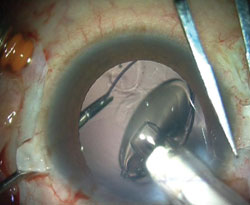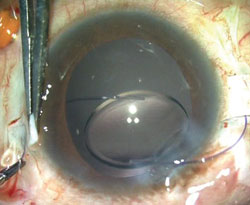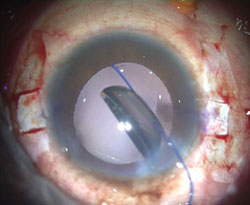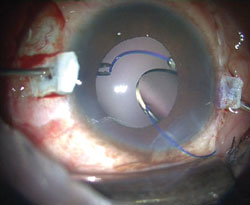Gluing a viable alternative to suturing posterior chamber IOLs in unstable bags
A handshake technique enables proper handling of the haptics in a closed-globe procedure to fix a subluxated IOL, surgeon says.
Click Here to Manage Email Alerts
 Soosan Jacob |
Gluing is a suitable method of posterior chamber IOL implantation in complex cases with unstable capsular bags, according to one surgeon.
Sutured posterior chamber IOLs and IOLs implanted in the bag with endocapsular rings are particularly challenging, Soosan Jacob, MS, FRCS, DNB, MNAMS, said in an email interview.
“There are many worst-case scenarios where the glued IOL proves a very effective alternative,” Dr. Jacob, OSN Asia-Pacific Edition Editorial Board Member, said. “I now deal with many cases of progressive types of subluxated cataracts with a primary glued IOL.
This is especially important in those progressive cases of subluxation where, even if surgery has been carried out with an endocapsular ring and the IOL has been placed in the bag, the progressive nature of the zonulodialysis can result in a late subluxation of the IOL-ring-bag complex.”
Gluing a posterior chamber IOL is best suited in eyes with absent or deficient capsular support or decentered, subluxated or dislocated sulcus- or scleral-fixated IOLs, Dr. Jacob said.
“It is especially difficult to perform surgeries and try to re-fix the subluxated IOL with conventional techniques because of the associated fibrosis of the anterior capsule and the bag,” she said. “This is another situation where the glued IOL is very effective.”
Closed-globe technique
The basic IOL gluing technique involves creating two 2.5 mm × 2.5 mm lamellar scleral flaps placed 180° apart. A 23-gauge infusion cannula or anterior chamber maintainer is used to maintain optimal globe formation.
Sclerotomies are made 1 mm from the limbus, under the scleral flaps. An anterior vitrectomy is performed with a 23-gauge vitrector inserted through the sclerotomy or an anterior vitrector inserted through a corneal paracentesis. The leading haptic of the IOL is inserted through a corneal-scleral section and externalized through the sclerotomy with 23-gauge MicroSurgical Technology (MST) forceps.
|
|
|
|
As an IOL is injected into the anterior
chamber, the tip of the haptic is caught with MST forceps and brought to the
exterior while the injection is continued gently.
Images: Jacob S |
|
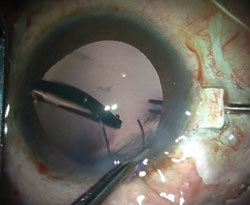 The injector is slowly withdrawn and the second haptic trails outside the wound. An assistant holds the first haptic as the surgeon flexes the second haptic into the anterior chamber and into the jaws of a MicroSurgical Technology forceps inserted through a second sclerotomy. |
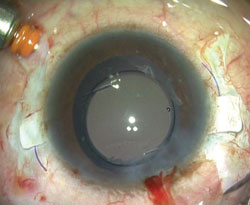 The second haptic is brought to the exterior of the anterior chamber. A bent 26-gauge needle is used to create a tunnel at the edge of the scleral flap. Vitrectomy is performed to clear prolapsed vitreous from the scleral bed. Both haptics are tucked intrasclerally. The tucked haptics are adjusted until centration is achieved. Fibrin glue is used to affix the scleral flaps and seal the main port, side port and conjunctiva. |
|
|
|
|
The handshake technique can be used to
resolve cases in which one of the haptics is not caught or is inadvertently
released. One MST forceps is used to hold the haptic and another forceps is
introduced through the opposite sclerotomy or side port. The first hand
transfers the haptic to the second forceps. |
|
The trailing haptic is similarly brought to the exterior through the opposite sclerotomy. The haptics are fixated transsclerally into scleral pockets created at the edge of the flap with a 26-gauge needle. Lastly, fibrin glue is used to affix the scleral flaps, Dr. Jacob said.
A closed-globe technique is useful in cases involving a subluxated three-piece foldable IOL or non-foldable IOL, Dr. Jacob said.
After making lamellar scleral flaps and sclerectomies, the subluxated IOL is grasped with the 23-gauge forceps, and vitrectomy is performed to release vitreous traction. A handshake technique is used to grasp each haptic at its tip, which is externalized through the sclerotomy. The haptics are tucked into scleral tunnels created at the edge of the scleral flaps, and the flaps are glued down.
“A subluxated single-piece PMMA IOL may also be similarly attempted, taking great care to maneuver gently to avoid cracking the haptic at the haptic-optic junction,” Dr. Jacob said. “A single-piece foldable IOL cannot be similarly re-fixed. In this situation, I prefer to explant it and perform a glued IOL.”
Foldable IOL technique, handshake technique
A foldable glued IOL technique can be used with any three-piece foldable implant. This technique is identical to the basic method, except for the mode of IOL insertion into the anterior chamber. A 2.8-mm keratome is used to create a corneal incision once the infusion cannula or anterior chamber maintainer has been fixed and the flaps and sclerotomies completed. The corneal incision may be enlarged slightly to allow easy IOL injection. A side-port incision may also be used. The injector is introduced into the anterior chamber, and the 23-gauge forceps are inserted through the sclerotomy under the scleral flap.
A pushing-type injector is preferable to a screwing-type injector, but the latter can also be used with an assistant’s help. The injector tip should be within the mouth of the incision. Wound-assisted injection can cause sudden, uncontrolled entry of the IOL into the eye and subsequent IOL drop, Dr. Jacob said, and thus should be avoided.
The handshake technique involves holding the haptic with forceps and directing another set of forceps through the opposite sclerotomy or side port. The haptic is then passed from one forceps to the other and back again until it is held in the desired manner at the desired point.
“The exteriorization of the haptics is a key step in the glued IOL,” Dr. Jacob said. “[The surgeon] needs to be familiar with the handshake technique as a means of transferring the haptic from one hand to the other.”
Holding the haptic at its tip before externalizing it can prevent it from snagging on the sclerotomy while being externalized, Dr. Jacob said.
“For this reason, this handshake transfer of the haptic between the two MST forceps is continued until the tip of the haptic is caught by the forceps on the side to which the haptic is to be exteriorized,” she said. “This technique then allows easy intraocular maneuvering of the entire haptic or IOL within a closed-globe system.” – by Erin L. Boyle and Matt Hasson

- Soosan Jacob, MS, FRCS, DNB, MNAMS, can be reached at Dr. Agarwal’s Eye Hospital, 19 Cathedral Road, Chennai, India 600086; +91-44-2811-6233; fax: +91-44-2811-5871; email: dr_soosanj@hotmail.com.
- Disclosure: Dr. Jacob has no relevant financial disclosures.

